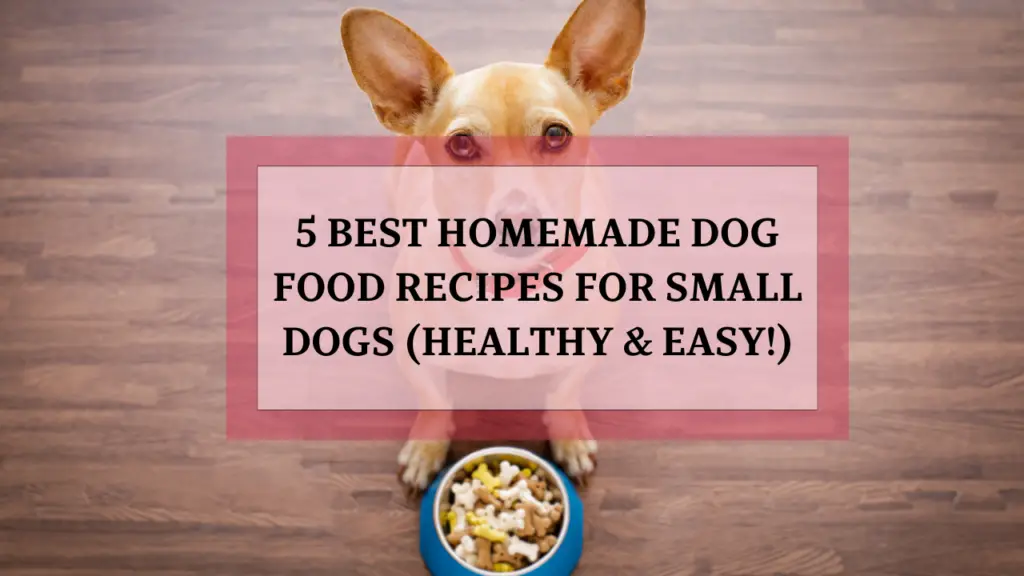Ever looked at your tiny dog and thought, “You deserve better than dry, boring kibble”? You’re not alone. More and more pet parents are turning to homemade dog food—and for good reason. When it comes to small dogs, every bite matters. Their little bodies need big nutrition, and what you feed them can make a huge difference in their energy, health, and even their lifespan.
But let’s be honest… cooking for your dog can feel overwhelming at first. What ingredients are safe? How do you get the right balance of nutrients? And how do you make something your dog will actually eat?
That’s exactly what this guide is here for. We’ll walk you through everything you need to know about homemade dog food for small dogs—from what makes their dietary needs different to how to prep meals, plus tons of tips, tricks, and yes, easy recipes.
And if you’re just looking for some quick meal ideas to get started, check out our 5 Best Homemade Dog Food Recipes: Nutritious and Easy Meals for Your Furry Friend for ready-to-make dishes your pup will love.
Let’s dive in and give your small dog the healthy, homemade meals they deserve!
Homemade Dog Food Nutrition 101
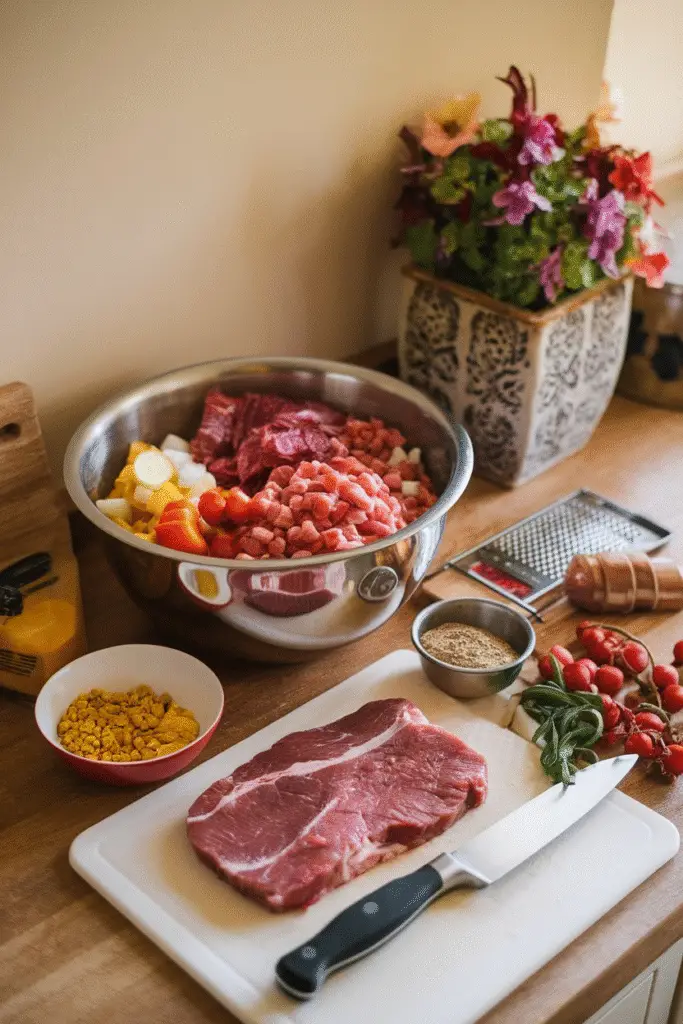
Getting the right balance of nutrients is key when it comes to making homemade dog food for small dogs. These little pups have specific dietary needs that must be met to keep them happy, healthy, and full of energy. Let’s break down the basics of what makes a complete and balanced homemade meal for your dog.
What a Balanced Homemade Dog Meal Should Include
Protein Sources: Chicken, Turkey, Beef, Eggs, Fish
Protein is the foundation of your dog’s diet. It supports muscle development, immune health, and overall vitality. For small dogs, lean proteins like chicken, turkey, and beef are great options. You can also mix in eggs and fish (like salmon or sardines) for variety and added nutrients. If your pup suffers from food sensitivities or allergies, check out our guide on 4 Homemade Dog Food Recipes for Skin Allergies: A Comprehensive Guide for protein swaps that are gentle on sensitive skin.
Healthy Carbs: Brown Rice, Quinoa, Sweet Potatoes
Carbs often get a bad rap, but the right kinds can be incredibly beneficial. Brown rice, quinoa, and sweet potatoes provide energy, fiber, and essential vitamins. They’re also easy to digest—especially important for small breeds with sensitive stomachs.
Veggies That Are Dog-Safe: Carrots, Spinach, Peas
Not all vegetables are dog-friendly, but many can add vital nutrients to your dog’s bowl. Try steamed or finely chopped carrots, spinach, or peas. They’re rich in vitamins, low in calories, and perfect for tiny teeth.
Healthy Fats: Omega-3s from Fish Oil or Flaxseed
Fats support brain function, promote a shiny coat, and help absorb fat-soluble vitamins. For small dogs, just a little goes a long way. Add a spoonful of fish oil or ground flaxseed to meals for a safe, healthy boost. If you’re looking to fine-tune your meals further, our post on the Best Healthy Homemade Dog Food Recipes: A Complete Guide for Pet Owners includes more tips on how to balance fats and other key nutrients for small breeds.
Supplements: Calcium, Multivitamins (and When to Use Them)
Even with fresh, whole foods, you might need to fill nutritional gaps—especially calcium, which is essential for bone health. Crushed eggshells, dog-safe bone meal, or a vet-approved supplement can do the trick. Always consult your vet before adding any multivitamin to make sure it’s tailored to your dog’s needs.
Ingredients to Avoid in Homemade Dog Food
Not everything in your kitchen is safe for dogs. Here are the big no-no’s:
Toxic Foods for Dogs: Onions, Garlic, Grapes, etc.
Some foods that are totally fine for us can be dangerous—even deadly—for dogs. Stay far away from onions, garlic, grapes, raisins, macadamia nuts, and chocolate. These are toxic and should never make it into your dog’s bowl.
High-Fat or Spicy Ingredients
Greasy or fatty foods (like bacon, sausage, or butter-laden scraps) can cause pancreatitis in dogs, especially small breeds. Likewise, spicy foods and heavy seasonings can upset their stomachs and lead to health issues.
Seasonings and Sauces Meant for Humans
Skip the salt, sauces, and seasonings. Dogs don’t need the flavor enhancers we crave, and many ingredients in sauces (like garlic powder or onion powder) are harmful. Keep it simple and clean.
How to Get Started With Homemade Dog Food for Small Dogs
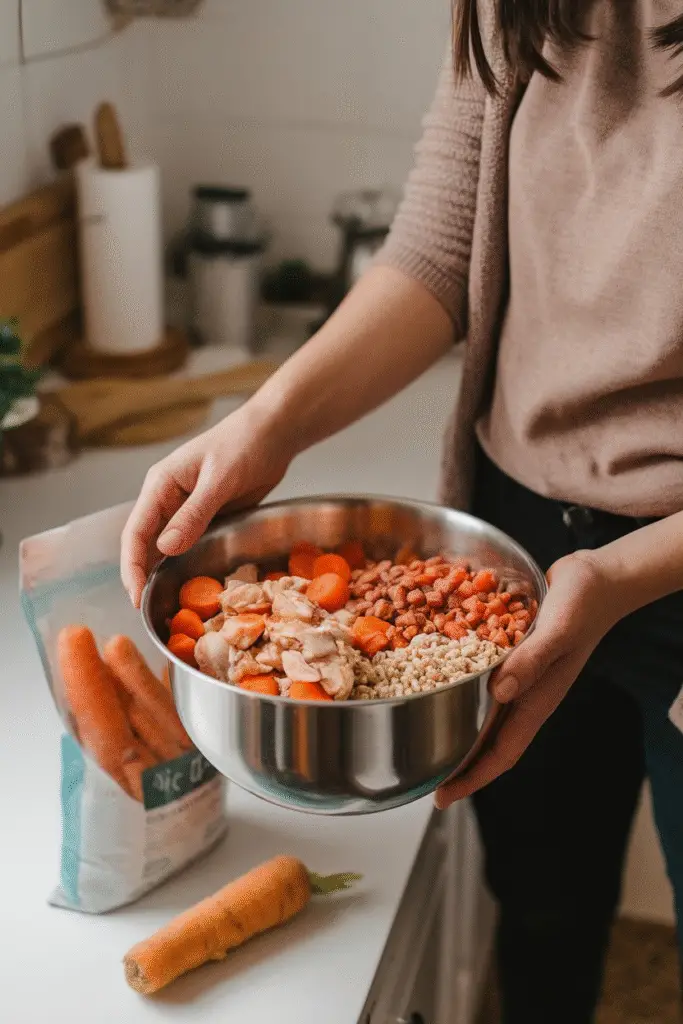
Ready to ditch the kibble and start cooking for your small dog? Great! But before you start chopping veggies and boiling chicken, there are a few important steps to follow. Here’s how to make the transition safe, smooth, and stress-free for both you and your pup.
Vet Consultation: Why It’s Non-Negotiable
Let’s get this out of the way: You need to talk to your vet. Small dogs are more sensitive to nutritional imbalances, and what works for one breed might not be right for another. A quick consultation can help you figure out your dog’s specific needs—like how much protein they require, what supplements to include, and how to avoid common deficiencies.
Bonus: If you’re also interested in baking some healthy treats, your vet can weigh in on safe ingredients. Once you’re ready, you can explore ideas like our Best Homemade Dog Treats: Healthy, Easy Recipes for Your Furry Friend to round out your pup’s snack menu.
Transitioning From Kibble to Homemade: Step-by-Step
You don’t want to shock your dog’s digestive system by switching foods overnight. Here’s a gentle way to do it:
- Start slow: Mix 75% of your dog’s usual kibble with 25% homemade food.
- Gradually increase: Every few days, bump up the homemade portion and reduce the kibble.
- Watch for signs: Look for any stomach issues like diarrhea, vomiting, or loss of appetite. If that happens, slow down the transition.
Most small dogs adjust well within 7–10 days. Keep an eye on their weight and energy levels during the process.
Measuring Portions Correctly Based on Weight and Activity Level
Small dogs burn calories differently than large breeds. A Chihuahua who lounges all day doesn’t need the same amount of food as a lively Miniature Poodle who goes on daily walks. Use your dog’s weight and activity level to determine how much to serve. Your vet can help calculate this, or you can use a dog food calculator online as a baseline.
Storage and Meal Prepping Tips
Making homemade food in batches can save tons of time, but storage is key to keeping it safe and fresh.
Fridge vs Freezer
- Fridge: Store a few days’ worth of food in airtight containers. It’ll last 3–5 days.
- Freezer: For longer storage, freeze meals in individual portions. Most homemade dog food can stay frozen for up to 2 months.
Portioning in Advance
Pre-measuring meals before you store them is a game-changer. Use reusable silicone containers or freezer-safe bags and label them by date. It’s super helpful when life gets busy and you need a quick grab-and-serve option.
Shelf Life of Homemade Meals
Always follow the 3–5 day fridge rule, and when in doubt—toss it out. Unlike commercial kibble, fresh food doesn’t have preservatives, so it can spoil fast. That’s why portioning and freezing are so useful.
Want to try your hand at treats that don’t need flour or long shelf lives? We’ve got you covered with these Homemade Dog Treats Without Flour: Healthy and Delicious Recipes that are perfect for smaller dogs with sensitivities.
Top 5 Easy Homemade Dog Food Recipes for Small Dogs
Cooking for your small dog doesn’t have to be complicated. In fact, these five recipes are simple, healthy, and perfect for tiny tummies. Each one comes with easy-to-follow steps, dog-safe ingredients, and nutritional benefits that cater to the needs of small breeds.
Let’s dig in!
1. Chicken & Rice Comfort Bowl
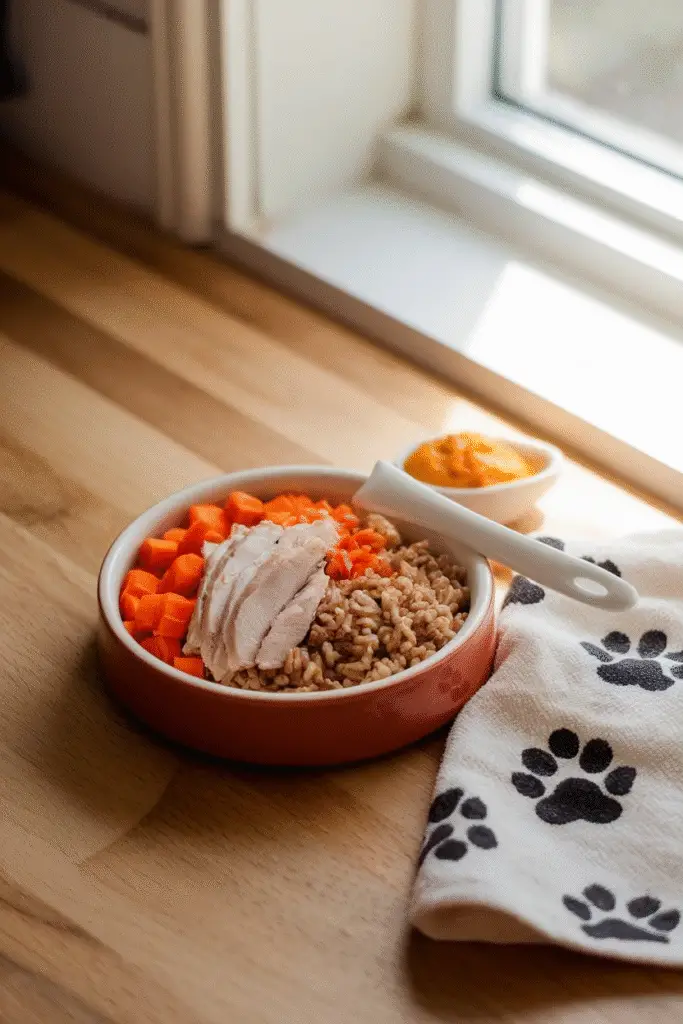
Why it’s great: This gentle recipe is ideal for dogs with sensitive stomachs. It’s easy to digest and full of the good stuff.
Ingredients:
- 1 cup boneless, skinless chicken breast
- ½ cup cooked brown rice
- ¼ cup finely chopped carrots
- 1 tbsp plain pumpkin purée (optional for digestion)
- 1 tsp fish oil
Instructions:
- Boil the chicken until fully cooked. Shred it into small pieces.
- Steam the carrots until soft.
- Mix chicken, rice, and carrots in a bowl.
- Add pumpkin and fish oil before serving.
Nutrition tip: High in lean protein and gentle carbs, this meal is a go-to for upset tummies or recovery days.
Want a tasty treat to pair with this meal? Try these Homemade Dog Biscuits Recipes: Healthy and Delicious Treats for Your Pup—perfect for rewards or training.
2. Turkey Veggie Medley
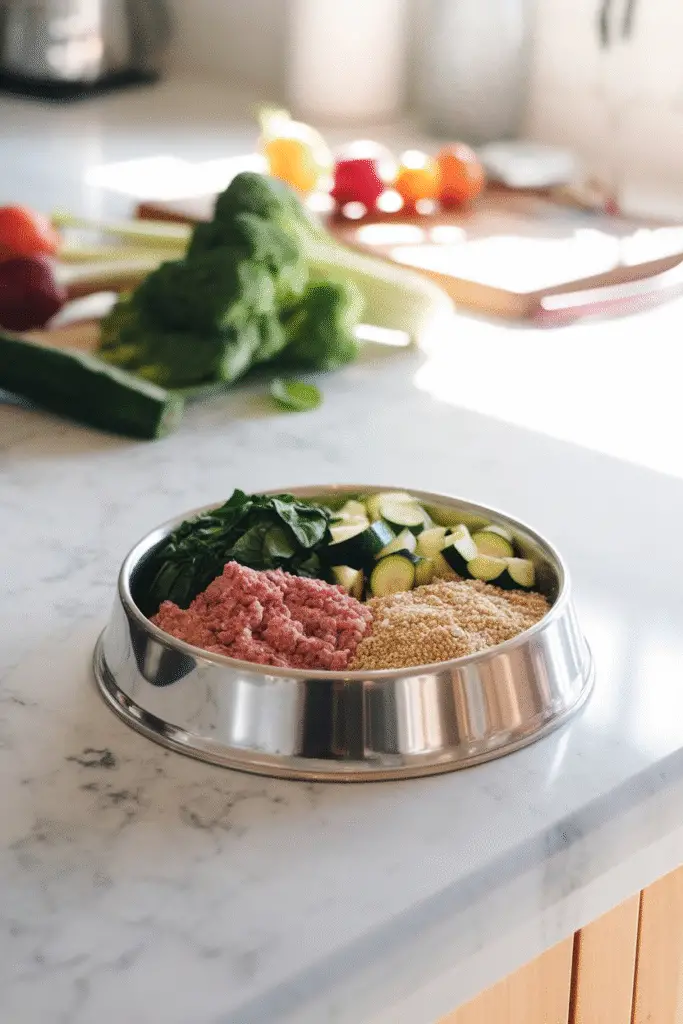
Why it’s great: Lean turkey paired with colorful veggies makes for a balanced, low-fat meal.
Ingredients:
- 1 cup ground turkey
- ¼ cup chopped spinach
- ¼ cup diced zucchini
- ¼ cup cooked quinoa
- 1 tsp flaxseed oil
Instructions:
- Cook turkey in a skillet until no longer pink.
- Steam spinach and zucchini until tender.
- Combine all ingredients in a mixing bowl.
- Add flaxseed oil before serving.
Nutrition tip: This recipe is rich in fiber and antioxidants, perfect for keeping your pup energized and regular.
3. Beef & Sweet Potato Stew
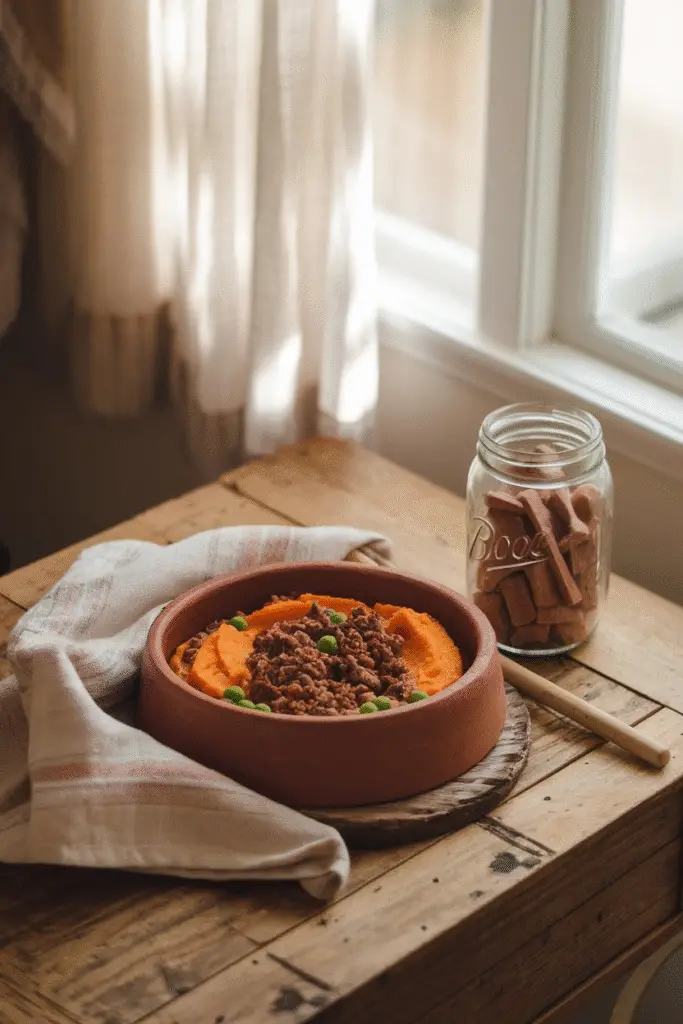
Why it’s great: This hearty dish is perfect for picky eaters and cold days.
Ingredients:
- 1 cup lean ground beef
- ½ cup cooked sweet potatoes
- ¼ cup green peas
- 1 tsp olive oil
- Dash of turmeric (optional)
Instructions:
- Cook beef in a pan and drain any excess fat.
- Mash sweet potatoes after boiling.
- Mix everything in a pot, simmer for a few minutes.
- Let cool before serving.
Nutrition tip: Sweet potatoes are a great source of beta-carotene and fiber, while beef brings essential amino acids.
4. Salmon & Spinach Superfood Mix
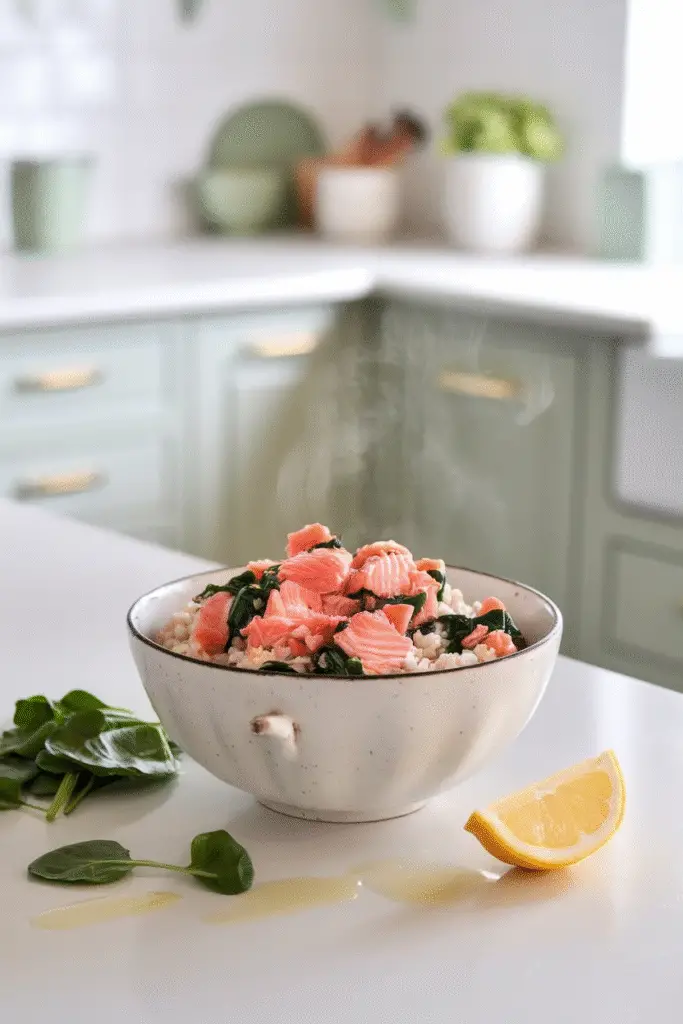
Why it’s great: Packed with omega-3s, this recipe supports skin and coat health.
Ingredients:
- 1 fillet of boneless, skinless salmon
- ½ cup chopped spinach
- ¼ cup brown rice
- 1 tsp fish oil
Instructions:
- Bake salmon at 350°F until cooked through. Flake with a fork.
- Steam spinach and cook brown rice.
- Mix all ingredients and let cool.
Nutrition tip: This antioxidant-rich meal boosts your dog’s immune system and reduces inflammation.
5. Egg & Quinoa Breakfast Bowl
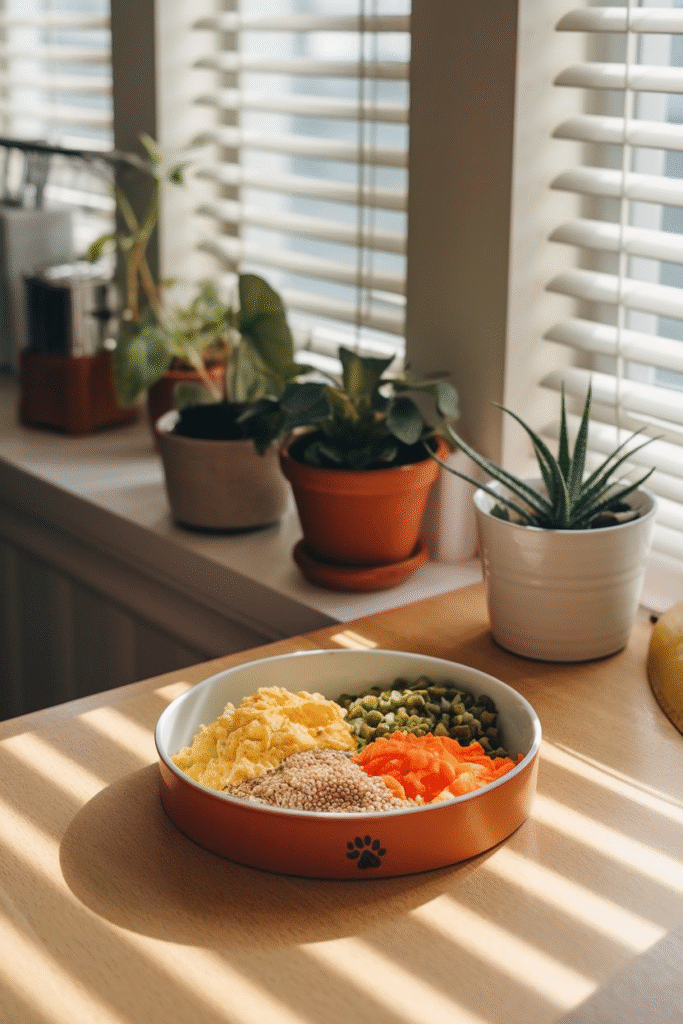
Why it’s great: A protein-rich breakfast perfect for an active start to the day.
Ingredients:
- 2 scrambled eggs (no salt or butter)
- ¼ cup cooked quinoa
- ¼ cup finely chopped green beans
- 1 tbsp grated carrot
Instructions:
- Scramble eggs in a nonstick pan.
- Steam green beans and cook quinoa.
- Combine all ingredients in a bowl.
- Let cool before serving.
Nutrition tip: This meal is rich in complete protein and essential nutrients for metabolism and muscle health.
Need a quick snack idea between meals? Your pup will love these Dog Cookies Recipes: Easy & Healthy Homemade Treats for Your Pup. They’re flour-free, easy to make, and perfect for little dogs.
Homemade Dog Food Feeding Chart for Small Dogs
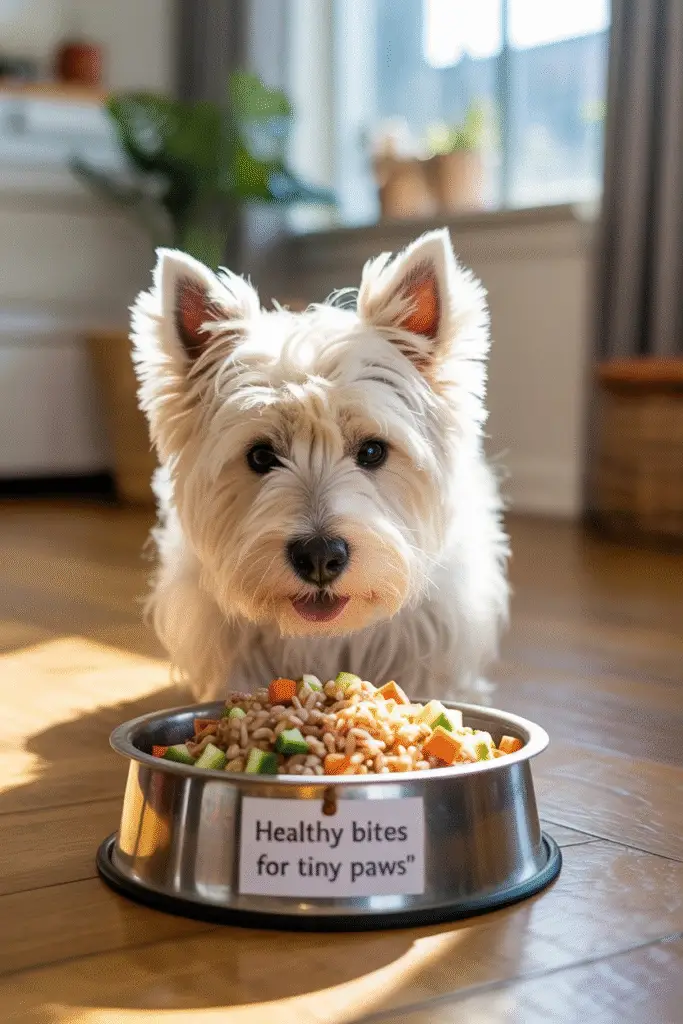
Feeding your small dog the right amount of food is just as important as choosing the right ingredients. Small breeds have fast metabolisms, and while they may not need a lot in volume, every bite counts in terms of nutrition. Here’s how to plan and portion their meals properly.
How Much to Feed Based on Weight and Age
There’s no one-size-fits-all answer, but here’s a simple breakdown you can use as a starting point:
| Dog’s Weight | Puppy (2–12 months) | Adult (1–7 years) | Senior (7+ years) |
|---|---|---|---|
| 2–5 lbs | ¼ – ½ cup per day | ¼ cup per day | ¼ cup per day |
| 6–10 lbs | ½ – ¾ cup per day | ½ cup per day | ½ cup per day |
| 11–15 lbs | ¾ – 1 cup per day | ¾ cup per day | ¾ cup per day |
💡 Tip: Divide the total into two or three meals per day to avoid blood sugar dips in smaller breeds.
Always adjust based on activity level, age, and overall health. And remember—your vet should help you fine-tune the portions for your dog’s exact needs.
Daily and Weekly Meal Planning Ideas
Planning out your dog’s meals in advance makes homemade feeding way easier—and keeps their diet balanced. Here’s an easy sample schedule:
Daily Plan:
- Breakfast: Egg & Quinoa Bowl (or rotate with Chicken & Rice)
- Dinner: Turkey Veggie Medley
- Snack: Try these Homemade Pumpkin Dog Treats: Easy & Healthy Recipes for Your Pup – perfect for a fiber-rich bite!
Weekly Rotation Tips:
- Use different proteins each week (chicken, beef, salmon, turkey)
- Rotate in veggies like peas, green beans, and spinach
- Don’t forget healthy fats like fish oil or flaxseed oil
- Include a treat day with something special—these No Bake Dog Treats are quick to make and don’t require an oven!
The Bottom Line
Making homemade dog food for small dogs isn’t just about providing meals—it’s about showing love in every bite. With the right balance of protein, healthy carbs, veggies, and supplements, your furry friend can thrive on a diet that’s fresh, nourishing, and tailor-made for their needs.
Remember, it’s not about being perfect. It’s about doing your best to keep your pup healthy, happy, and excited for mealtime. Whether you’re whipping up a Chicken & Rice Comfort Bowl or prepping a week’s worth of Turkey Veggie Medley, your effort matters.
Oh, and don’t forget the treats—healthy snacks like homemade dog biscuits or flour-free cookies add a little joy between meals.
Your small dog deserves the best—and now you’re equipped to give it to them.

Hi, I’m Ali Tarek, the founder of Animalsman. I’ve always been passionate about pets, especially dogs and cats, and I created this website to share practical tips, easy recipes, and helpful care advice for fellow pet lovers. My goal is to make pet care simple, enjoyable, and accessible for everyone. When I’m not writing or curating content, you’ll usually find me spending time with my furry friends or learning new ways to keep them happy and healthy.

